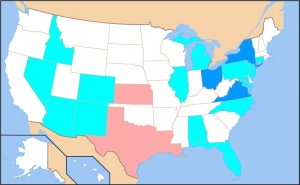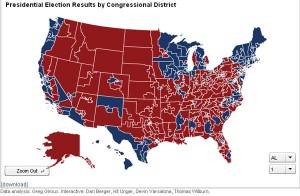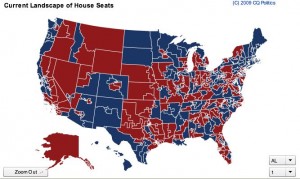Jim Geraghty sets out to disprove the notion that the GOP is “becoming a regional party.” What he actually proves is that (1) geographical maps are not a terribly helpful way to analyze what’s happening in an institution where membership is allocated by population, and (2) snapshot analysis is not a very good way to evaluate claims about trends. Here are the maps—showing the results of the 2008 presidential and House elections—Geraghty wants us to look at so we can see how absurd it is to think Republicans only have support in the South:
This isn’t actually that illuminating, though, because a map dominated by big empty districts doesn’t give you a great sense of where the actual votes are concentrated. And since the disputed claim is that the GOP is at risk of becoming a regional party, you sort of need to look at how things are changing over time. If you do that, you might point to some other maps. For instance, where did each party enjoy net gains and losses?

But as I said, eyeballing physical maps tends to be misleading, unless you literally want to know how each party is faring by acreage. What those maps demonstrate is that there are big geographical chunks of the country outside the South that lean Republican. But that’s not really to the point. The question is whether the party’s political power is concentrated in the South. Geraghty says it’s clearly not, because “The South amounts to 44 percent of the Republican House delegation, which means 56 percent has to come from somewhere else.” I’m inclined to throw in Missouri, which is technically part of the Midwest as the Census carves it, but that only gets us up to 48 percent, and given that the South is the most populous region of the country, that’s not wildly out of proportion. So that puts a knife in the “regional party” canard, right? Thing is, in 1994, the same states only accounted for 34 percent of the Republican House delegation. And as Bill Bishop has been arguing for some years now, we’ve become sufficiently mobile that geographical clustering by ideology tends to be self-reinforcing, at least at the county level: Conservative leaning areas and liberal leaning areas both tend to become more so over time, other things equal.
If the claim we’re concerned with is whether there are Republicans outside the South, then Geraghty is clearly right: There are Republican districts all over the country. If the question is, instead, which geographical constituencies do Republican elected officials represent, it’s equally clear that they’re disproportionately southern, and have become much more so recently. And there’s probably some tipping point where that regional constituency exerts enough pull on the agenda of the Republican caucus that there’s a setup for another feedback loop. So it’s not that Geraghty is wrong so much, it’s that he’s got the right answer to the snapshot question, but isn’t even taking up the analysis of the dynamic, which is what most of the talk I’ve heard about the Republicans “becoming a regional party” is actually about.






6 responses so far ↓
1 sidereal // Apr 30, 2009 at 4:06 am
Point perhaps better made by including a map that skews county data by population, like this one.
That state-level ones that adjust for population are less granular, but still instructive, like this one
2 the teeth // Apr 30, 2009 at 12:53 pm
Not horribly relevant to your post, but while it’s a border state, I’m not comfortable calling Missouri ‘southern.’ Almost 1/2 the population is in the St. Louis metro area, and that half, at least, is as midwestern as Cleveland or Des Moines.
3 Number 6 // Apr 30, 2009 at 1:59 pm
Missouri is midwestern. Kansas City and St. Louis are both fairly cosmopolitan urban areas. The middle of the state is dominated by rural folks, not a few of whom can be fairly called rednecks or bumpkins.
But speaking as Missourian, I can assure that I am not a Southerner, and frankly resent the hell out of the implication.
Other than that, I tend to agree.
4 the teeth // Apr 30, 2009 at 3:01 pm
To elaborate on Number 6’s post — Michigan and Ohio and Indiana have a similar population of ‘redneck’ types in the rural areas (or more to the point, smaller towns) … sometimes it looks like this is the whole of Indiana. Redneck does not Southern make.
5 Sam // Apr 30, 2009 at 5:34 pm
“If the question is, instead, which geographical constituencies do Republican elected officials represent, it’s equally clear that they’re disproportionately southern, and have become much more so recently. And there’s probably some tipping point where that regional constituency exerts enough pull on the agenda of the Republican caucus that there’s a setup for another feedback loop. ”
Given that the South is the most small-government part of the country, why is this a bad thing again? Bring on the feedback loop! Unless you actually want more Chafees and Snowes influencing the party instead?
6 Barry // May 7, 2009 at 11:42 am
“Given that the South is the most small-government part of the country, why is this a bad thing again? Bring on the feedback loop! Unless you actually want more Chafees and Snowes influencing the party instead?”
I think that 2001-08 have pretty much disproven any ‘small government party’ claim by the right, the Republican Party and the South.
Of course, I’m using ‘small government’ to mean ‘small government, even when it’s stuff I want and approve of’.